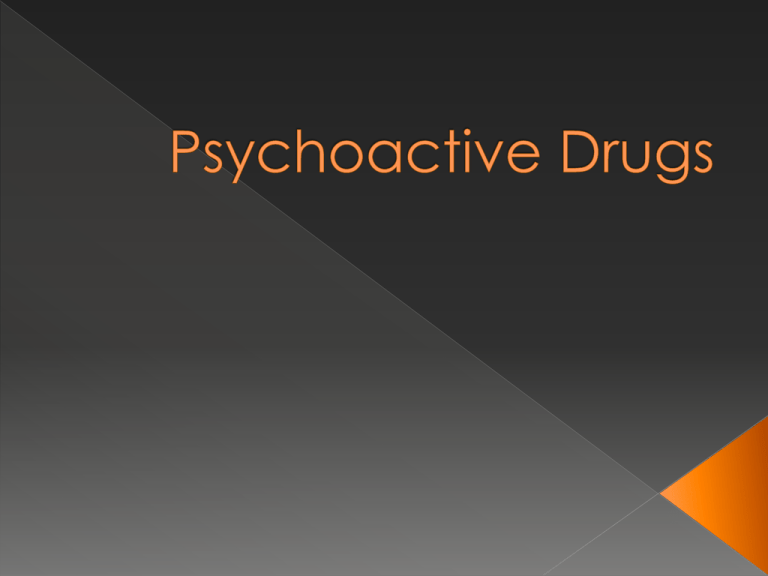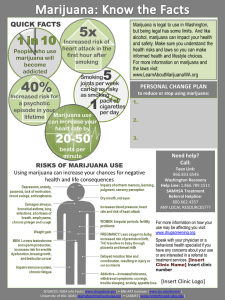Psychoactive Drugs
advertisement

To understand the importance of being drug free To gain insight and knowledge on different psychoactive drugs and their affects on the body Alters a person’s sensations, feelings, thought, or functions of the nervous system Drug misuse › Taking drug for a purpose other than that for which it was intended Drug abuse › Causes damage to the user › Impairment of the user’s ability to function › Behavior harmful to others Curiosity Rebellion Peer pressure Anxiety Depression Boredom Physical dependence › Characterized by withdrawal symptoms Psychological dependence › Craving fore the mood changes › Strongly Influenced by social factors Swallowing Smoking Snorting Injecting Suppositories (absorption) Made from opium, which comes from a poppy plant Different effects › Relieves pain › Drowsiness › Euphoria Heroin, hydrocodone, oxycodone, morphine Effects on the body Collapsed vein Heart problems Abscesses Cellulites Liver disease HIV/AIDS/Hepatitis Death Withdrawal symptoms Abdominal cramping Diarrhea Dilated pupils Goose bumps Nausea Vomiting Agitation Anxiety Muscle aches Increased tearing Insomnia Runny nose Sweating Yawning Late symptoms of withdrawal include: Abdominal cramping Diarrhea Dilated pupils Goose bumps Nausea Vomiting Slow down overall activity of nerves Examples › Tranquilizers › Alcohol Elevates mood, increase feelings of wellbeing, and increase energy and alertness Stimulant drugs › Cocaine › Methamphetamine › MDMA (ecstasy) › Caffeine Derives from a coca bush Two forms of cocaine › Powder cocaine- AKA “blow” or “coke” › Rock cocaine- AKA “crack” or “rock” Heart- increase heart rate and blood pressure Brain- constricts blood vessels in the brain, causing strokes, seizures, violent behavior Lungs and respiratory system- damage nose Gastrointestinal tract- constricts blood vessels (nasal perforation) , permanent lung damage which causes ulcers Kidneys- kidney failure Sexual function- can’t finish what you started, impair ejaculation White, odorless, bitter-tasting crystalline powder Many street names › Meth, speed, chalk, ice, crystal, glass Taken a number of different ways › orally, intranasal, injection or smoking Highly addictive Short term Increase wakefulness Increase physical activity Irritability Tremors Convulsions Anxiety Paranoia Aggressiveness Delusions HIV/Hepatitis B & C death Long term Permanent damage to blood vessels in brain Strokes Extreme dental problems (meth mouth) Irregular heartbeat Anorexia Delusions HIV/Hepatitis B & C death The “feel good drug” Popular in nightclub settings Produces feelings of increased energy, euphoria, emotional warmth, and distortions in time, perception, and tactile experiences Serotonin affected in the brain › Regulates mood, aggression, sexual activity, sleep and sensitivity to pain Increase heart rate/BP Nausea Blurred vision Faintness Chills or sweating Interfere with body’s ability to regulate temperature liver, kidney, cardiovascular system failure death Yes, it is a drug Naturally produced in the leaves and seeds of many plants Causes increase alertness; gives most people a temporary energy boost High doses cause: › Anxiety, dizziness, headaches, and the jitters Common symptoms: Drug craving Irritability Loss of energy Depression Fearfulness Wanting to sleep a lot or difficulty in sleeping Shaking Nausea and palpitations, Sweating Hyperventilation Increased appetite A mind–altering substance A mixture of dry, shredded green and brown mix of flowers, stems, seeds and leaves Comes from a plant called cannabis sativa Ancient china used the hemp plant to make paper Gateway drug Cannabis sativa plant contains 50-70 percent more carcinogenic hydrocarbons than tobacco smoke Chemicals, chemicals chemicals!!!! Over 400 chemicals in Marijuana Main active chemical in Marijuana is THC ( Delta-9tetrahydrocannabinol) Inhaling Smoking like cigarette (most common) In a pipe Consuming Eating it in its natural form Putting it in food, then eat Brewing tea the food Red, bloodshot eyes Trouble remembering things Slowed reaction time Difficulty concentrating Sleepiness Anxiety Paranoia Altered time perception Tremors Nausea Headache Decreased coordination Breathing problems Increase appetite Reduced blood flow to brain Change in reproductive organs Respiratory infection Impaired memory and learning ability Cough Phlegm Chronic bronchitis Frequent chest colds Increase risk of cancer of the head , neck, lungs and respiratory tract Most commonly used illegal substance in the United States Individual of all ages use marijuana 37% of all Americans ages 12 and older have used marijuana at least once in their life time Significant percentage of teens and young adults use marijuana 20% of individuals aged 12-17 50% of individuals aged 18 to 25 48% of seniors in high school have used it at least once and 22 % have used it in the past month Just say no, and walk away Tell who ever is using marijuana that its bad for them Avoid people who are using it, when they are using it Suggest doing something else instead Psychedelics are AKA “hallucinogen” Alters cognition and perception Types of Psychedelic drugs › LSD- aka “acid › Mushrooms- aka “magic mushrooms” or “shrooms” Experiences differ, mostly involve strong visual and auditory components

![[H1]Researching Society with MicroCase Online](http://s3.studylib.net/store/data/007737973_2-9d35b9e42208c660471ccaa373bd3b78-300x300.png)






